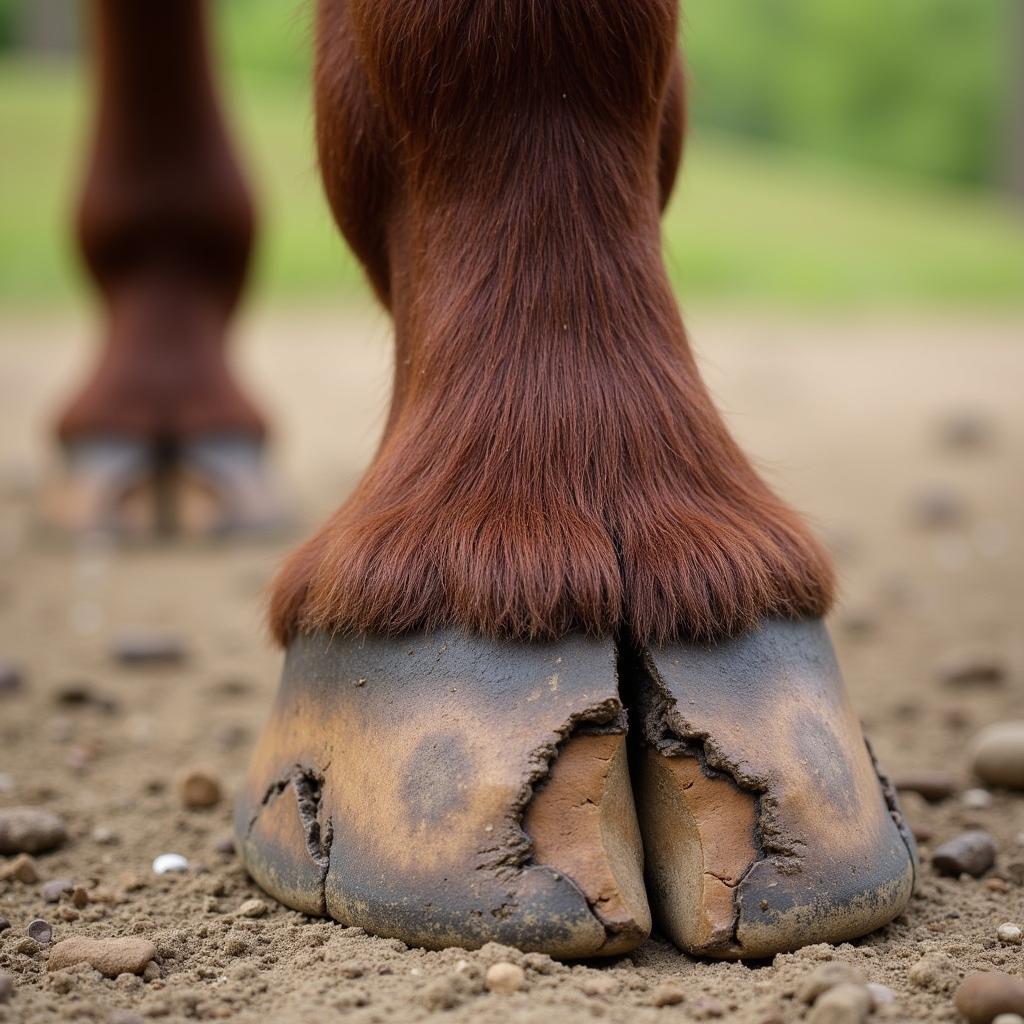Hoof Repair For Horses is a crucial aspect of equine health and well-being. A healthy hoof is essential for a horse’s comfort, performance, and overall soundness. This comprehensive guide will delve into the intricacies of hoof repair, covering everything from common hoof problems to advanced repair techniques.
 Close-up view of a damaged horse hoof, showing cracks and chips.
Close-up view of a damaged horse hoof, showing cracks and chips.
Understanding the anatomy and function of the hoof is fundamental to effective hoof repair. The hoof wall, sole, frog, and white line all play vital roles in supporting the horse’s weight and absorbing shock. Regular hoof care, including trimming and balancing, is essential for preventing problems and maintaining healthy hoof growth. However, even with diligent care, horses can still experience hoof issues due to injury, disease, or environmental factors.
Common Hoof Problems and Their Solutions
Several factors can contribute to hoof problems in horses, ranging from improper shoeing to underlying health conditions. Some of the most common hoof problems include cracks, chips, abscesses, thrush, and laminitis.
-
Cracks: Hoof cracks can vary in severity from superficial fissures to deep splits that can penetrate sensitive tissues. Treatment options for hoof cracks depend on the depth and location of the crack, and may include trimming, patching, or the application of hoof repair products.
-
Chips: Hoof chips, often caused by trauma or uneven terrain, can compromise the integrity of the hoof wall. Small chips can often be addressed with regular trimming, while larger chips may require patching or the use of hoof glue for horses.
-
Abscesses: Hoof abscesses are painful infections within the hoof capsule. Treatment typically involves draining the abscess and providing appropriate medications.
-
Thrush: Thrush is a bacterial infection that affects the frog and surrounding tissues, often caused by prolonged exposure to moisture and unsanitary conditions. Treatment involves cleaning the affected area and applying topical antifungal medications.
-
Laminitis: Laminitis, a serious inflammatory condition affecting the laminae, requires prompt veterinary attention.
Addressing Hoof Cracks and Chips
Dealing with hoof cracks and chips effectively requires careful assessment and appropriate intervention. Superficial cracks may only require regular trimming and balancing. Deeper cracks, however, may necessitate patching or the application of horse hoof repair products to stabilize the hoof wall and promote healing. Similarly, small hoof chips can often be managed with trimming, while larger chips may require hoof glue for horses or other specialized repair techniques.
The Importance of Nutrition in Hoof Repair
Nutrition plays a vital role in hoof health and repair. A balanced diet rich in essential nutrients, such as biotin, zinc, and amino acids, is crucial for strong, healthy hooves. Supplementation with zinc for horses or tri amino for horses can be beneficial in cases of nutritional deficiencies.
Dr. Emily Carter, DVM, Equine Specialist, emphasizes the significance of nutrition: “A balanced diet is the foundation of healthy hooves. Adequate levels of biotin, zinc, and amino acids are essential for optimal hoof growth and repair.”
 Illustration of a healthy horse hoof anatomy.
Illustration of a healthy horse hoof anatomy.
When to Consult a Veterinarian or Farrier
While some hoof problems can be managed with basic first aid and routine farrier care, certain conditions require professional intervention. If you notice signs of lameness, swelling, heat, or discharge from the hoof, it is essential to consult a veterinarian or farrier immediately. These professionals can diagnose the problem accurately and recommend appropriate treatment options.
“Early intervention is key to successful hoof repair,” advises John Miller, Certified Farrier. “Don’t hesitate to contact a professional if you’re concerned about your horse’s hooves.”
Conclusion
Hoof repair for horses is a multifaceted process that requires careful attention and appropriate intervention. By understanding the common causes of hoof problems and implementing effective treatment strategies, horse owners can help maintain the health and soundness of their equine companions. Remember, prompt diagnosis and treatment are crucial for successful hoof repair and preventing long-term complications. Regular hoof care, a balanced diet, and timely professional intervention are essential for ensuring your horse’s hooves remain strong and healthy.
FAQs
- How often should my horse’s hooves be trimmed?
- What are the signs of a hoof abscess?
- Can I treat thrush myself, or should I call a vet?
- How can I prevent hoof cracks in my horse?
- What is the best diet for healthy hooves?
- How can I tell if my horse has laminitis?
- What are the different types of hoof repair products available?
Need help with hoof repair or other horse health concerns? Contact us at Phone: 0772127271, Email: [email protected] or visit us at QGM2+WX2, Vị Trung, Vị Thuỷ, Hậu Giang, Việt Nam. Our 24/7 customer service team is ready to assist you. Check out our other resources on hock pain in horses symptoms.